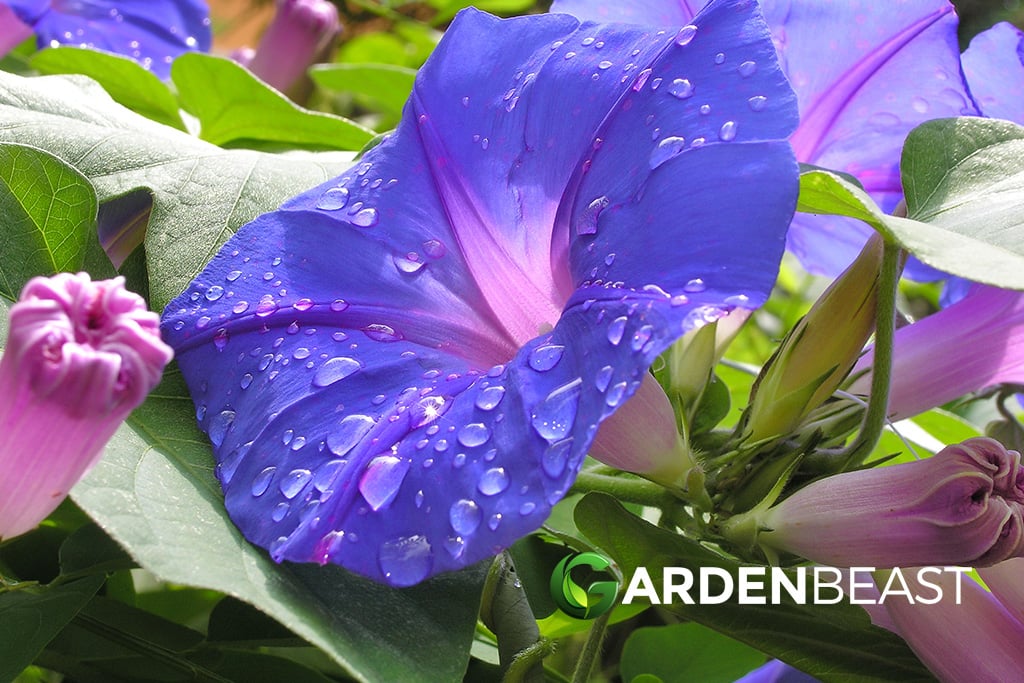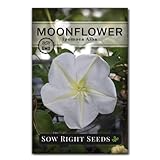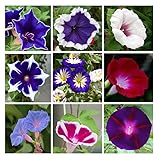Morning Glory, also known as Ipomoea, is an ornamental vining flower that grows in most places around the world annually or perennially. Requiring little care, it is quite popular with gardeners. Morning glories can often be found outdoors adorning walls, fences, or pergolas but also indoors in containers.
Most species of Ipomoea are native to tropical America, although they can be found spread across temperate and subtropical areas in Asia. The name Morning Glory can refer to various types such as Ipomoea, Convolvulus, Merremia, or Calystegia. However, you don’t have to worry about proper identification, as seed packets or plant tags always indicate its species and genus.
News of Ipomoea’s beauty has spread far and wide, capturing the attention of plant aficionados from different cultures around the globe. In Chinese tradition, the short life of a Morning Glory flower is a symbol for the finite amount of time we have in this world. In the Victorian era, the Morning Glory represented a love that never ends.
Morning Glory flowers have also inspired internationally acclaimed artists such as Sopheap Pich, Suzuki Kiitsu, and Georgia O’Keeffe to create paintings and sculptures. It is also often mentioned in literature, poetry, and folklore. Let’s find out more about this delicate and versatile plant.
About Morning Glory
- Morning glory flowers bloom splendidly in the morning and wilt by the afternoon.
- Because they are most magnificent in September, they are nicknamed back-to-school vines.
- The Morning Glory has been used for medicinal purposes in Mesoamerican and Asian countries for centuries. Tea brewed from its roots was used as an expectorant and diuretic, while the tea from its leaves was a popular remedy for headaches.
- Mesoamerican tribes would consume Morning Glory seeds in rituals for their hallucinogenic properties.
- People have also used the species Ipomoea alba in the fabrication of rubber, and the sulfur in its juice to vulcanize rubber.
- Morning Glories can tolerate a variety of conditions. In colder climates, they are mostly annual plants, although some species can tolerate the winter cold.
- Ipomoea Aquatica, or water spinach, is a variety commonly used as a green vegetable in Asian cuisines. However, in the U.S. it is illegal to grow, sell, import, or possess without a permit.

Morning Glory Features: An Overview
- Because of their tolerance for poor, dry soils, beauty, and fast growth rate, gardeners use them to create summer shade on building walls, thus keeping the building cooler.
- Unlike other vines, they do not grow roots for climbing, so you will need a trellis or lattice. On the bright side, you won’t have to worry about Morning Glories damaging your walls.
- Popular varieties for Ipomoea include ‘Heavenly Blue’, ‘Sunspots’, moonflower, the cardinal climber, and the cypress vine. The moonflower is a species of night-blooming Morning Glory.
- The common Morning Glory has heart-shaped leaves and fragile trumped-shaped flowers that appear in a wide range of colors, including purple-blue, red, magenta, white, pink, and bicolor.
- Their colorful flowers are quite fragrant, beloved by hummingbirds and butterflies. Also, they might attract rabbits, groundhogs, or deer.
- Morning Glory seeds are poisonous to animals and children, so keep them out of their reach.
- You might have noticed that Morning Glories resemble sweet potatoes with their leaves and flowers. These two plants belong to the same genus, Ipomoea.
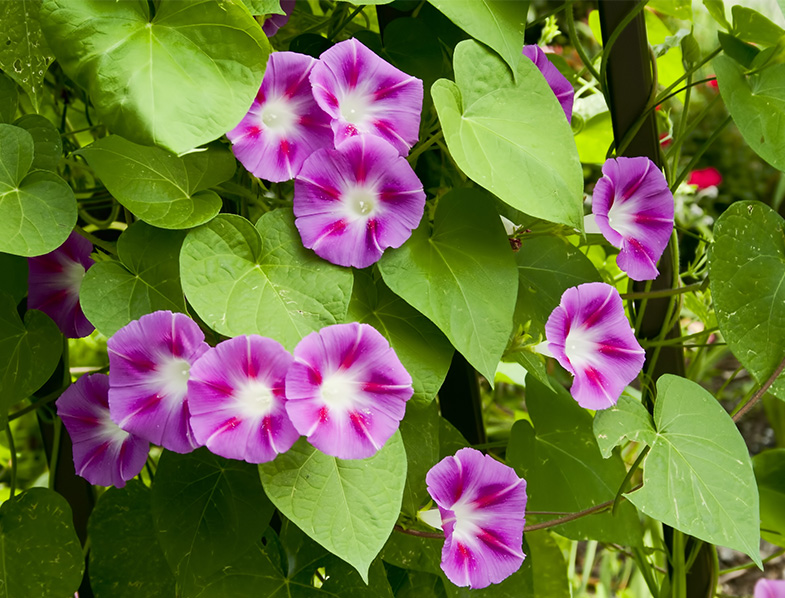
Growing Morning Glory
This fast-growing vine is an excellent choice for gardeners who want to decorate vertical objects, pergolas, or cover an ugly fence. The Morning Glory thrives in the sunniest conditions, so place it in hot and open locations. Nonetheless, it will tolerate very light shade. Make sure you offer slender support to twist around. Alternatively, Morning Glories can also be used as a beautiful ground cover.
All these twisting and crawling vines can become a hassle, so if you’re not committed to cleaning up regularly, this plant might not be the right choice for your garden. Old flowers should be removed before they form seedpods and cover your entire garden.
Heavy overgrowth can be managed by pruning the plant and leaving only 30 to 40 percent. You can also grow them outdoors in pots to keep them contained. Perennials should be allowed to stay in place during winter, and require just some cut-off in the spring.
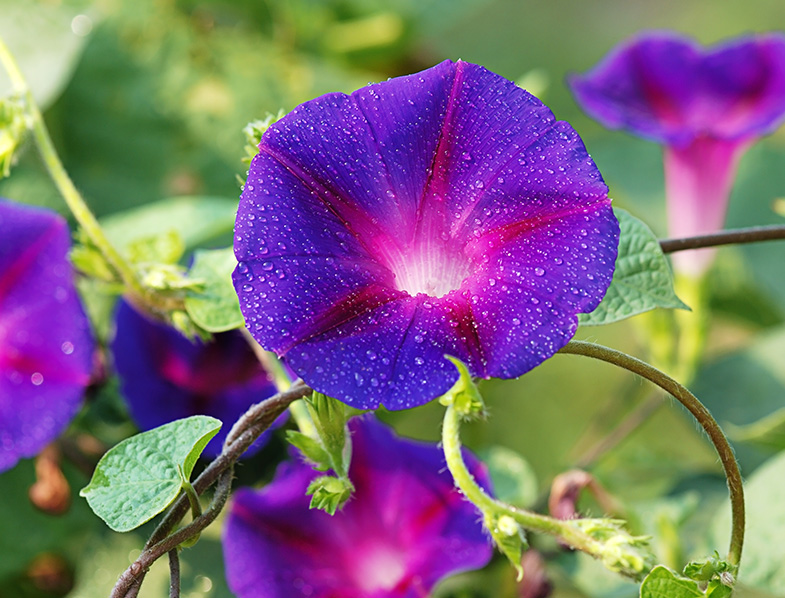
Morning Glory plants are very easy to grow and require very little attention while established. Surprisingly, it can thrive in any type of soil, and they seem to do quite well in poor soil types. Ipomoea produces more flowers when it is stressed, in an attempt to reproduce and create another generation.
Because of this, many gardeners believe that it doesn’t need to be fertilized. Morning Glories do require monthly fertilizer during the growing season. Until the plant is comfortable in the new environment, keep the soil constantly moist and well-drained.
If you plan on growing these beautiful flowers indoors, make sure there’s a string lattice or a wire in front of a sunny window that they can climb. Luckily, Ipomoea will bloom abundantly all year round as a house plant. For best results, make sure the soil is moist, not soggy, and with good drainage. Do not overfertilize, or you will get more foliage than flowers.
Morning Glory plants are low-maintenance and are rarely bothered by pests. However, you might see aphids, spider mites, beetles, or leaf miners feeding on the vines. If you notice any pests, try to pick them up by hand, as using chemicals will impact the health of pollinators and beneficial insects.
Watering Morning Glory
Outdoors, Morning Glories don’t need much in regards to watering. Normally, they can survive and thrive on rainfall alone. However, during periods of droughts, it is important to help them out with a soaking once or twice per week.
If you live in an area that has less than one inch of rain per week, or if your plant is indoors in a container, you should also water them weekly. During winter, cut back watering. If you notice black rot and rust, your plant might be too wet, or the air circulation might be poor. Remember, less is more with the Morning Glory!
At planting and during establishment, Morning Glories require consistent watering. If you are planting seeds, make sure to soak them in warm water for 24 hours to ensure germination. After planting, keep the soil constantly moist to a depth of 1 inch (2.5 cm).
If it dries out, the seeds might not germinate, so check it every two or three days. Seedlings also require moisture to grow strong roots. Outdoors, weekly watering should be sufficient. Water indoor seedlings twice per week or when the soil feels dry.
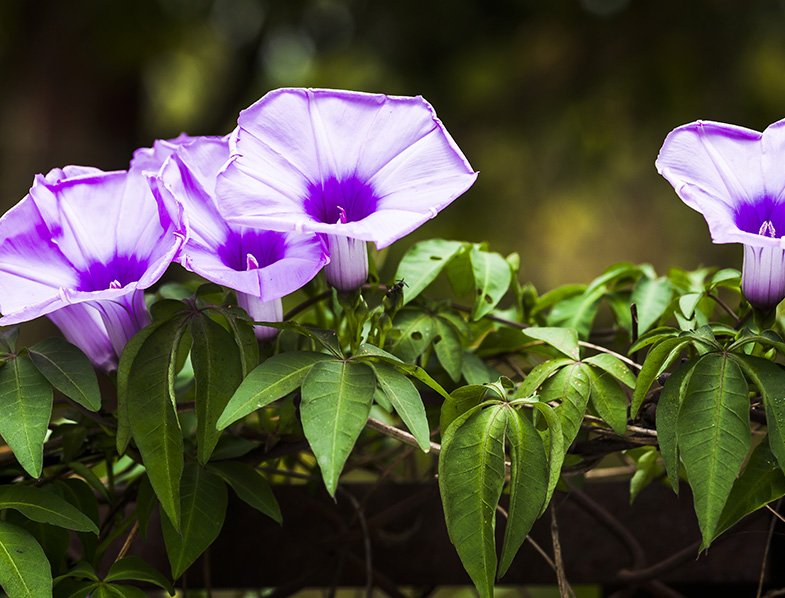
Propagating Morning Glory
Morning Glories can be easily propagated by seeds planted directly in the garden after the soil has warmed up and there is no threat of frost. Indoors, you can start the seeds approximately 4 to 6 weeks before the last frost. These gracious plants are slow to flower. If you live in an area with a short growing season, it is best to start Morning Glories from indoor seeds.
Harvesting the seeds is quite easy, and can be a fun project to do with the family. Just look through the vines and take some dead flowers that are ready to drop off. Next, crack open the pod at the end of the stem. If the seeds are black, collect them in a paper bag. Place the bag in a warm, dark place and allow them to dry for one week. To see if the seeds are ready, pierce one with your thumbnail. If they are too hard to puncture, they need more time drying.
- Beautiful – Large premium packets of Moonflower (Ipomoea alba) seeds. Brilliant white, trumpet-shaped blooms make an elegant addition to your summer garden! Plant wildflower style or in carefully arranged baskets. Minimum of 13 g per packet (about 55 seeds).
- Productive - Moonflower germinates in 5-10 days when soil temps are 60-70°F. Plant 1/2” deep and space 6-8” apart in an area with full sunlight during the day and no light at night. This variety will grow 1-3’ tall with a spread of 1-4’. Moonflower will mature in 84-90 days, plant in USDA zones 3-9.
- Exotic - Photosensitive vines require darkness to produce blooms. Be sure to move away from bright yard or street lights at night. Flowers open up in the evening and stay open all night but close up during the day. For best results, provide trellis or fencing for the vines to climb.
- Easy to Grow - Instructions included on each packet. Plus, we are available to answer all your questions. If these seeds don’t germinate, we will happily make it right for you
- Safe and Sustainable - Our operation is fully solar powered, and Sow Right Seeds has taken the Safe Seed Pledge to sell only fresh Non-GMO heirloom seeds for you and your family.
- QUALITY - All seeds packaged by Seed Needs are intended for the current and the following growing seasons. All seeds are stored in a temperature controlled facility that is free of significant amounts of moisture.
- QUANTITY - Seed packets by Seed Needs offer generous quantities. You can share with friends and family, or save your extra seeds until the next season, if properly stored.
- PACKETS - Each packet displays a beautiful illustration of the variety to be grown, as well as detailed seed sowing information on the reverse side as well. Measures 3.25” wide by 4.25” tall.
- PROMISE - Seed Needs will never knowingly supply GMO based seed products. The vast majority of our seeds are open pollinated & heirloom, with the exception of a few hybrids.
- GERMINATION - Seed Needs packets contain some of the freshest seed available. Direct from the growers. If sown correctly, you will begin seeing results in only a matter of days.
Last update on 2024-10-04 / Affiliate links / Images from Amazon Product Advertising API
Don’t forget that seeds have a thick coat, so to ensure successful germination, they need a little bit of help. We suggest to rub them with sandpaper or an emery board and keep them in water for 24 hours. Alternatively, you can nick them before planting. Normally, germination takes about one week at 70-80 degrees Fahrenheit (20-26 °C).
Ipomoea does not like to be transplanted. Biodegradable pots are the best option for your seeds, as they reduce damage to the roots. Just place them directly into the ground and in time they will completely disappear.
Sow the seeds about ½ inch deep and make sure they have 8 to 12 inches spacing around them. Be very careful, as the vines grow very fast and can get tangled up. Once the seedlings are 6 inches tall, it is time to provide some support for them. If you are planting in suspended pots, you can simply let them spill over the edge.
In Conclusion
Morning Glories are beautiful and low-maintenance plants, popular with gardeners from around the world. Their flowers bloom splendidly in the morning and wilt by the afternoon. This short-lived beauty has made them symbols of love and the passing of time in many cultures.
Although they require little care and are great for decorating vertical objects, overgrowing can become a hassle. Luckily, they don’t require a lot of water and can be easily propagated from seeds. Morning Glory vines can bring old-fashioned charm to any garden or indoor space. We believe the hardest decision about Morning Glories is not whether you should get one or not, but which color to choose!
